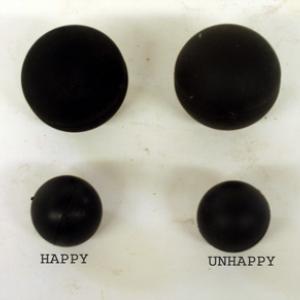College of Liberal Arts & Sciences
1R40.30 - Happy - Unhappy Balls
The happy - sad ball set has one ball that is much like a super ball and one ball that will absorb all of the energy and therefore will not bounce. The bouncing ball is made from polyneoprene and the non-bouncing ball is made from polynorbornene.
- Rod Cross, "Collision of a Happy Ball with a Sad Ball", TPT, Vol. 60, #1, Jan. 2022, p. 22.
- Kelley D. Sullivan, "What’s in a Name: Why Do We Call a Bouncy Ball Bouncy?", TPT, Vol. 57, #4, Apr. 2019, p. 229.
- David Kagan, "Happy Balls, Unhappy Balls, and Newton's Cradle", TPT, Vol. 48, #3, Mar. 2010, p. 152.
- Rod Cross, "The Coefficient of Restitution for Collisions of Happy Balls, Unhappy Balls, and Tennis Balls", AJP, Vol. 68, #11, Nov. 2000, p. 1025.
- Rod Cross, "The Bounce of a Ball", AJP, Vol. 67, #3, Mar. 1999, p. 222.
- Guenter Schwarz and Paul J. Haigh, "Demonstrating Elastic and Inelastic Collisions Using Bouncing and Nonbouncing Balls", AJP, Vol. 37, #3, Mar. 1969, p. 333.
- Bill Franklin, "Sad and Happy Balls", Teaching About Impulse and Momentum, p. 4.16.
- Jodi and Roy McCullough, "Energy with Happy and Sad Balls", The Role of Toys in Teaching Physics, p. 4.88.
- Pat Murphy, Ellen Macaulay, and the Staff of the Exploratorium, "That's the Way the Ball Bounces", Exploratopia, p. 138.
- Borislaw Bilash II, “Smart and Stupid Balls“, A Demo A Day – A Year of Physical Science Demonstrations, p. 204.
Disclaimer: These demonstrations are provided only for illustrative use by persons affiliated with The University of Iowa and only under the direction of a trained instructor or physicist. The University of Iowa is not responsible for demonstrations performed by those using their own equipment or who choose to use this reference material for their own purpose. The demonstrations included here are within the public domain and can be found in materials contained in libraries, bookstores, and through electronic sources. Performing all or any portion of any of these demonstrations, with or without revisions not depicted here entails inherent risks. These risks include, without limitation, bodily injury (and possibly death), including risks to health that may be temporary or permanent and that may exacerbate a pre-existing medical condition; and property loss or damage. Anyone performing any part of these demonstrations, even with revisions, knowingly and voluntarily assumes all risks associated with them.

